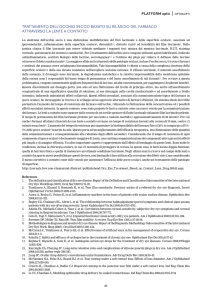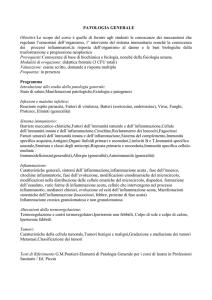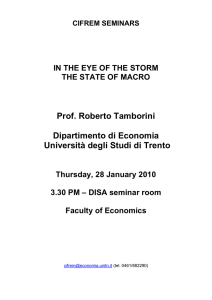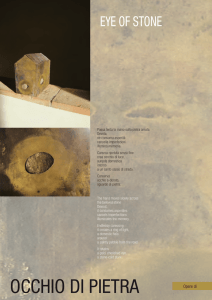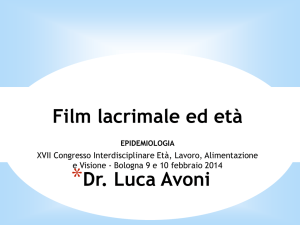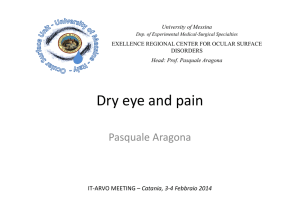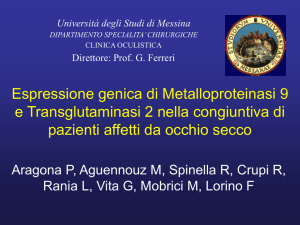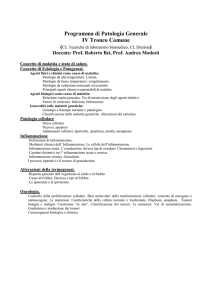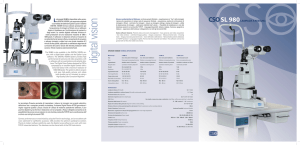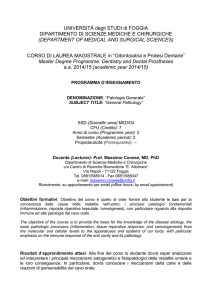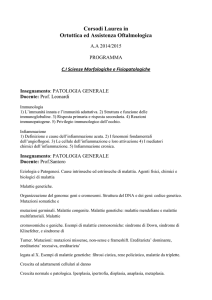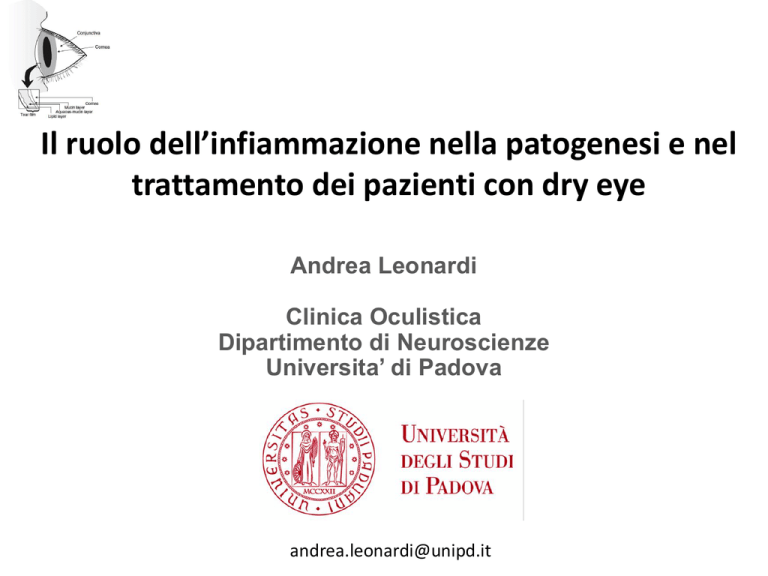
Il ruolo dell’infiammazione nella patogenesi e nel
trattamento dei pazienti con dry eye
Andrea Leonardi
Clinica Oculistica
Dipartimento di Neuroscienze
Universita’ di Padova
[email protected]
DED
Discomfort
Visual disturbance
Ocular surface
damage
Hyper osmolarity
Infiammation
MGD
Dry Eye Disease
Meibomian gland dysfunction
is a multifactorial disease of the tears
and ocular surface that results in
symptoms of discomfort, visual
disturbance, and tear film instability
with potential damage to the ocular
surface. It is accompanied by increased
osmolarity of the tear film and
inflammation of the ocular surface.
is a chronic, diffuse abnormality of the
meibomian glands, commonly
characterized by terminal duct
obstruction and/ or qualitative/
quantitative changes in the glandular
secretion. This may result in alteration
of the tear film, symptoms of eye
irritation, clinically apparent
inflammation, and ocular surface
disease.
DEWS The Ocular Surface, Apr 2007
MGD. IOVS 2011
Meccanismi principali della malattia dell'occhio secco
Instabilità del
film lacrimale
Perdita delle celluleModifiche dei lipidi
caliciformi
MGD Modifiche della flora
Infiammazione
delle palpebre
Rilascio di
esterasi/lipasi
Tossine
Iperosmolarità
Rilascio di citochine
Attivazione delle MMP
Danno cellulare
Infiammazione
Apoptosi
Stimolazione
nervosa
Adattato da Baudouin et al.
J Fr Ophthalmol 2007;30:239–46.
Osmolarita’ e infiammazione
produzione di lacrime
•Film iperosmolare
•Alterazioni
morfologiche e
biochimiche
•Infiammazione
evaporazione
di lacrime
Sostituti lacrimali ipotonici
Controllo stress ossidativo
Agenti viscosizzanti
Protezione dell’epitelio
Anti-inflammatori
Iperosmolarita`
Danno
cellulare
e morte
Infiammazion
e
Liu H, IOVS 2009; Chen Z, IOVS 2008; Liu H, Exp Eye Res 2006; Li DQ, IOVS 2004
oxidative stress can be a causative factor
for the development of dry eye disease
Uchino Y et al. (2012) Oxidative Stress Induced Inflammation Initiates Functional Decline of
Tear Production. PLoS ONE 7(10): e45805. doi:10.1371/journal.pone.0045805
Evaporazione
Iperosmolarità
Stress ossidativo
Iposecrezione
Th0
Viene prima
l’instabilità del film
lacrimale
o
l’infiammazione?
DED and Inflammation
•Decreased / inhibited tear
production
•Desiccating stress
•Oxidative stress
•Hyperosmolarity
•Pro-inflammatory cytokines
from the lacrimal gland
•Blinking abnormalities
mobilization and maturation of
ocular surface APCs
Th0
DED and Inflammation
Immune cells in DED
• NK cells
• Mature APCs
• Th1, Th17
• Dysfuncional Treg
Stevenson et al. Arch Ophthalmol. 2012
Desiccating stress models
DED and Inflammation
Dry eye as a mucosal autoimmune disease. Stern ME, et al. Int Rev Immunol. 2013
DED and Inflammation
Cytokines in DED
CT
Non-SS SS
Increased tear levels:
• INF-g, IL-1a, IL-1b, IL-6, IL-8, IL-17, TNFa, EGF, Fractalkine, IL-1RA, IP•
•
10, MMP-9
TLR, ICAM-1, VEGF-C, VEGF-D
CCL3, CCL4, CCL5, CXCL9, CXCL10, CCL20, CX3CL1
IL-6 concentration in tears has a strong correlation with the severity symptoms
and signs (CFS, and conjunctival lissamine staining)
IL-6
Yoon et al. Cornea 2007
Solomon et al. IOVS 2001
Pflugfelder et al. Curr Eye Res 1999
Tishler et al. Ophthalmology 1998
Enriquez-de- Salamanca et al. 2010
Proteomica
• Analisi peprtidi lacrimali tra 500 -25.000 Da
• Tecnologia complessa
– HPLC
– 2D-elettroforesi
– SELDI-TOF-MS + ProteinChip Reader
• Peptidi in Dry Eye:
– Aumento di mediatori dell’infiammazione
– Riduzione di proteine con funzione protettive
Grus. IOVS 2006
Biomarkers in DED
Over-expressed in DED
Downregulated in DED:
S100A6
S100A9
S100A8
S100A4
glutathione S-transferase P
(GSTP1)
annexin A1 (ANXA1)
lipocalin 1 (LCN1)
prolactin inducible protein (PIP)
lactotransferrin (LTF)
zinc-α-2-glycoprotein (AZGP1)
galectin 7 (LEG7)
cystatin S (CST4)
cystatin SN (CST1)
actin
cytoplasmic 1 (ACTB)
mammaglobin-B (SG2A1)
Paziente soggettivamente molto “sofferente”
Obiettività scarsa
Infiammazione congiuntivale
Sofferenza epiteliale corneale
Sintomatologia modesta
Sub basal plexus / inflammation
• Increased fiber #
•Sprouting
• Increased tortuosity
•Inflammatory cells
* Benitez-del-Castillo et al. IOVS 2007, Zhang et al. Cornea 2005, Tuisku et al. Exp Eye Res 2008
Confocal Microscopy
Terapia
Scopo della terapia è il miglioramento e la
conservazione della qualità di vita
• Riduzione dei sintomi irritativi
• Riduzione dello stress iper-osmolare e
ossidativo
• Miglioramento della funzione visiva e della
fotofobia
• Protezione dal danno anatomico
• Numero di farmaci e di instillazioni
compatibili alle esigenze quotidiane
• Prevenzione e gestione dell’infiammazione
Trattamento dell’occhio secco
•
Increase tear volume
– systemic pilocarpine
– volumetric tear substitutes
– punctum plugs
•
Improve lubrication
– Non Newtonian tear substitutes
– Dilute tear film solutes
– Increase tear turnover
•
Improve mucus conditions
– gefarnate, Ecabet, N-Acetyl Cisteine,
TSP, P2Y, 15-(S)-HETE., Rebopamide
Reduce evaporation
– lipid tears
– lateral tarsorraphy
– life style adaptation
Improve/protect corneal epithelium
– semi compressive eye patching
– contact lenses
– amniotic membrane
•
•
•
Treat the lids
– Warm patches
– Antibiotics (Systemic Tetracyclin &
Derivatives), Macrolids
– Steroids and combo
– Omega 3-6 ointments
– Blink exercises
– loose & floppy eye lid correction
•
Control inflammation
–
–
–
–
–
–
•
Corticosteroids
NSAIDs
Cyclosporine A
Omega 3 Fatty Acids
Androgens
Tetracyclin & Derivatives
Supplement growth factors
– Autologous serum eye drops
– amniotic membrane
– NGF
algoritmo del trattamento
basato
sulla
Cortisonici
severità della
Acidimalattia
grassi essenziali
Modifiche
ambientali/dietetiche
omega 3-6
Ciclosporina
Trattamento di Livello
1
Tetracicline
Eliminare determinati
Lacrime artificiali
farmaci
Terapia delle
palpebre
Trattamento di Livello 2
Farmaci
antinfiammatori
Tetracicline
Punctal plugs
Farmaci
secretagoghi
Occhiali a
camera umida
Trattamento di Livello 3
Serum
Occlusione puntale
permanente
Lenti a contatto
Trattamento di Livello 4
Farmaci antinfiammatori per via sistemica
Intervento chirurgico
International Dry Eye Workshop. Ocul Surf 2007;5:163–78.
Anti-Inflammatory Treatment
Corticosteroids
Progenitor cell proliferation
Mast cell
Corticosteroids
Membrane phospholipids
T
cells
Membrane
Stabilization
Corticosteroids
Phospholipase A2
Arachidonic acid
Heparin
Histamine
PAF
Cyclooxygenase
Lipoxygenase
Cyclic endoperoxides
Hydroperoxides
Prostacyclin
(PCI2)
Thromboxane A2
(TXA2)
Leukotrienes
(LTC4, LTD4, LTE4, LTB4)
Prostaglandins
(PGF2, PGD2, PGE2)
Corticosteroids Provide the Most Comprehensive Coverage of the Inflammatory Cascade
Effect of Lipid Solubility on Glucocorticoid
Penetration
• The corneal epithelial levels of corticosteroid, administered both
as drops and ointments, follow their lipid solubilities.
• PHOSPHATE << FREE ALCOHOL <
ACETATE
• Inflammation disrupts the epithelial barrier and aids the
penetration of the less lipid-soluble molecules.
> Lipophilia < AC penetration
PHARMACOKINETICS OF TOPICAL CORTICOSTEROIDS
• ALCOHOLIC DERIVATIVES (intermediate lipophilia, biphasic polarity: AMPHIPHILIC
MOLECULES):
–
–
Higher penetration in AC
Corneal lesions enhance drug penetration
• PHOSPHATE DERIVATIVES Highly water soluble
–
–
Low penetration in the epithelium (lipophilic)
Transformed in alcohol by tear film phosphatases
• HIGHLY LIPOPHILIC SUBSTITUENTS (Butirrate, Acetate, Etabonate)
–
Higher activity in the epithelium lower in the stroma
–
Surface steroids
• FLUORINATED MOLECULES
–
Do not penetrate in AC
–
Surface Steroids
Topical CsA in Dry Eye
■ The long-term use of topical corticosteroids is limited by potential sightthreatening side effects, such as glaucoma, cataract, and infection
■ The only drug approved by the FDA in the US for treatment of DED
■ Requires several months to produce a clinical therapeutic effect
Clinical case
•
Female, 53. S. Sjögren.
•
Treated with topical, hospital preparation, of CsA
baseline
3 months
7 months
•
Subjective and objective improvement over time
•
No further use of topical corticosteroids and reduced use of tear substitutes
Reduction of inflammation (HLA-DR) with
CsA 0.1%
*
p=0.022
50000
45000
Median HLA-DR (AUF)
40000
35000
30000
IKERVIS
CsA
0.1%
vehicle
Vehicle
25000
20000
15000
10000
5000
0
Baseline
Month 6
SICCANOVE Study, Santen
• Treatment with topical anakinra, 2.5%, for 12
weeks was safe and significantly reduced
symptoms and corneal epitheliopathy in
patients with DED
• These data suggest that the use of a IL-1
antagonist may have a role as a novel
therapeutic option for patients with DED
• LFA-1/ICAM-1 inhibition as a therapeutic target in chronic ocular T cell–
mediated inflammation
• SAR 1118 is a potent inhibitor of T-cell activation, adhesion, migration,
proliferation, and cytokine release
• Significant improvement in CFS mean change from baseline (P < .05)
Il ruolo dell’infiammazione nella patogenesi e nel
trattamento dei pazienti con dry eye
• Patologia autoimmune localizzata
generata da uno sbilanciamento tra
meccanismi protettivi
immunoregolatori e proinfiammatori
della superficie oculare
• Conserva e rispetta la superficie
oculare
• Corretta gestione dell’infiammazione
[email protected]

